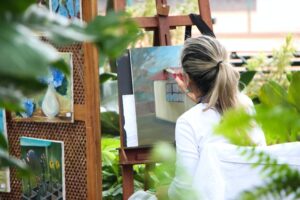What is Flow?
To be in a state of flow is to be utterly absorbed in an activity, with time seeming to pass in the blink of an eye. It is a mental state in which one’s whole being is completely immersed, typically in an activity which one enjoys and is skilled at. While flow typically occurs when undertaking creative pursuits, it can also be found in physical pursuits such as running, dancing, and playing sport.

The concept of flow was conceived by Mihaly Csikszentmihalyi, a respected psychologist whose work focused on the psychology of well-being, achievement, and a meaningful life. When we engage in an activity that promotes a state of flow, we derive many benefits including:
- Increased life fulfilment
- Increased happiness and joy
- Improved performance in that particular activity
- Further learning and development
- Feelings of serenity and loss of self-consciousness.
Lost Your Mojo? Time to find some flow.
It is not uncommon to feel like you have lost your mojo in life and question where your life is going at times. It might be that you got to where you thought you wanted but now that you’re there you feel unsatisfied. At times, we feel this way when outside pressures and other people’s expectations have dictated where to go.
To find happiness in life and rediscover our mojo, we have to act instead of sitting down and waiting for it to come to us. Often a lot of where we need to go comes from looking at the past and also looking for moments of flow that might already be occurring. Asking yourself the following questions might help you identify activities that procedure a state of flow:

- What actions energised you over the past year?
- What actions inspired you the most?
- When did you feel the proudest and what were you doing?
If you are unsure about what makes you happy and makes you flow, it might be time to try new things. You might want to pick up a musical instrument, try new sports, read some interesting books, or just start writing and see where you go!
Tips for Achieving Flow

Once we have found an activity we enjoy and feel relatively skilled at, it’s important to follow some simple rules to get the most out if it. These include:
- Setting clear goals as to what you are doing.
- Eliminate any distractions (phones, etc.) to ensure your flow is not disrupted.
- Add elements of challenge (set realistic but challenging goals).
- Select activities that provide immediate and unambiguous feedback.
Incorporating Flow into a Meaningful Life
In his work, Mihaly wrote “If a person sets out to achieve a difficult enough goal, from which all other goals logically flow, and if [they] invest all energy in developing skills to reach that goal then actions and feelings will be in harmony and the separate parts of life will fit together – and each activity will ‘make sense’ in the present as well as in the view of the past and of the future. In such a way, it is possible to give meaning to one’s entire life”.
Mihaly’s work ties in nicely with the work of psychologist Martin Seligman and his PERMA-V model. This model gives insight into how and what we need to be doing to be in a state of thriving and well-being, which ultimately lead to a flow state.
Seligman’s PERMA-V model includes the following:
- P – Positive emotion
- E – Engagement and connectedness
- R – Enhanced Relationships
- M – Meaning and purpose in their pursuits
- A – Sense of Achievement
- V – Vigour (vitality and energy through self-care).




